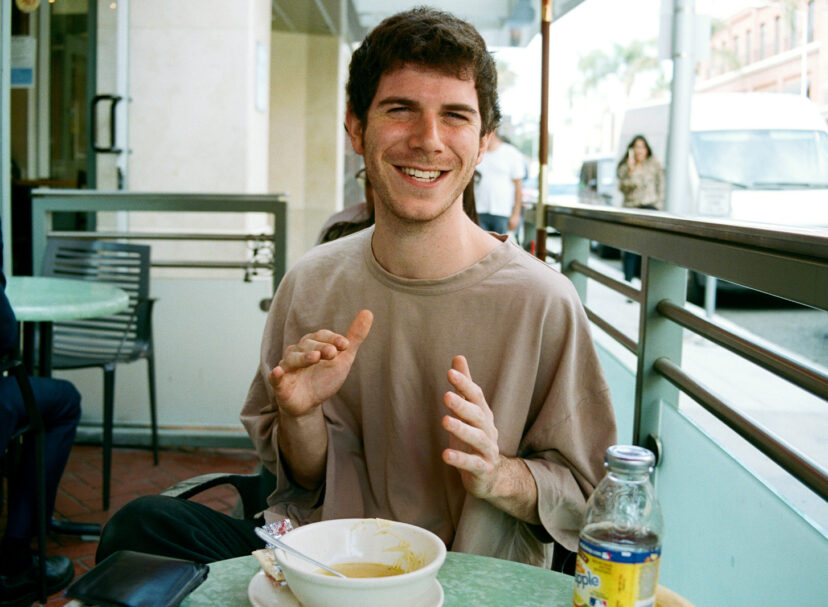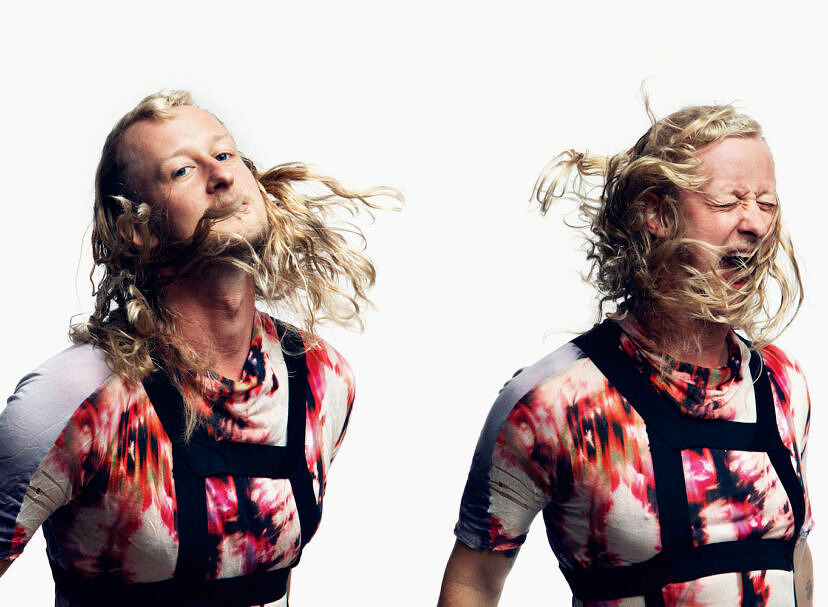Interview: Andy Fenwick
Solely as a cellist, Oliver Coates impresses not only on his own, past records, like Towards the Blessed Islands, but also on high-profile collaborations like Mica Levi’s Under the Skin soundtrack, or his starring role on Radiohead’s A Moon Shaped Pool. As a composer and arranger and cello-reinventor, he’s something again altogether. On his new release Shelley’s on Zenn-La, Coates recombines acoustic cello lines and beats with 707s, tape delay, and a Renoise sequencer, among other tools, to create compositions that unspool in surprising directions yet never depart from logic. In other words, Shelley’s on Zenn-La hits that ineffable artistic height of perfect execution while seeming unplanned; like nothing in this world while still like everything in the world. Sounds lace together and then unlace themselves. Percussion lines couple and uncouple. Repetitions are earned. Voices may not be voices. Cello is cello, on all but one track, but not as you had known cello before.
More impressively, Shelley’s on Zenn-La never departs the accessible world of (mostly instrumental) song format, at least within the contemporary realm of electronically manipulated or treated music. As you can see from Coates’s Spotify playlist for Ravelin, the formal label ‘acousmatic music,’ might not be too off the mark for this album, although Coates is doing this music live, sometimes while opening for Thom Yorke and his employment of electronic percussion (even when it’s still cello) might put him past that label, too. You could definitely go down a Stockhausen-like theory-discussion wormhole trying to vivisect Shelley’s On Zenn-La, but then again, why bother, when the final product produces such joy at the place where your ears meet it? As they have on Shelley’s on Zenn-La, intellectual processes or theories, within art, always have to find a way to freedom. It’s why two of Stockhausen’s students founded a little band called Can.

On Shelley’s On Zenn-La, was cello left behind by the compositional possibilities of electronic tools on any tracks, or was it always there, however minimally?
Yeah … actually from my end the cello is more direct this time. It’s given prominence in all tracks except for “Norrin Radd Dreaming” where I didn’t need it. I wasn’t sneaking anything around.
it goes:
- cello plays main drone, tape delay wonks and central chords
- cello pizzicato funk line throughout
- cello all melody/pads – everything except 707 drums
- central “folk” melody on cello, and the late piercing melodies and pads
- [ no cello]
- cello chunky chords throughout
- all cello in soft layers
- cello sampled and pitched around so it’s everywhere, the melodies pads & percussion
- CD bonus – cello plays all basslines and melodies
How much of Shelley’s On Zenn-La was conceived as a wholly new, different endeavor than any past albums?
I was making an album for RVNG intl >>> I held that in mind. In music you can bypass concepts and go into fantasies. Sometimes I think about Morton Feldman – the sound materials are nudged into existence and then I need to keep listening to them and they’ll tell me what to do next, moment to moment.
This new record seems to encompass so much, from the almost Augustus Pablo melodica-sounding figure on “Charlev” to Chicago house and techno elements. I hear Ricardo Villalobos; I hear Aphex Twin in the percussive lines of “Perfect Apple with Silver Mark.” Is there any music not usually associated with electronic (for lack of a better word) music that nonetheless inspired this work? Has anything new come into your listening that particularly influenced this new record?
These days I’ve been listening to DIY black metal and Hippos in Tanks artists largely. Last summer during this album time I was getting into New Age synth music like Enno Velthuys but also Neighbourhoods by Ernest Hood.
It’s a frame of reference for where I was living (London, Elephant & Castle) and how I felt about recording & programming small patterns into larger forms.
Musical influences don’t work for me in that direct way – I don’t channel other artists’ music. It’s more subterranean, perhaps about aesthetic motivation.
I had a discussion with the label founder about Presque Rien by Luc Ferrari, which is modified environmental recordings, little shimmers & interventions in the fabric of acoustic reality. I was asking myself why that constitutes a valuable piece of music. Then a few months later I had these tracks and this whole image.
Talk about Renoise – what features drew you to it? Have you exhausted it yet? Could you?
I’m so fond of this sequencer. I learned it years ago when on sea cruises, then forgot it, so relearnt it in 2017. I use it to sequence percussion, snippets of cello & synth and for some of its effects. It is like editing a game. It’s satisfying to make a whole track inside it and not mess with it anymore, not export to any other format. I used it on 4 of the 8. I’m exhausted cos we got a new baby boy, the software I think will be infinite for me.
Was the lovely vocal line on “A Church” improvised, or composed?
Improvised and partly composed. It used to belong to a track I made ages ago, bit of an Easter egg. I was sampling that older track on a plane to Australia, changing the speed, adding everything else you hear today fresh.
How did “Perfect Apple With Silver Mark” evolve? The percussion is fascinating. To me, this track feels like a balanced, aesthetic synthesis of your last two solo records.
There were ten versions all of which lasted 15 minutes and nothing like what you’ve heard. I dropped the whole track in an FX chain I’d made for a cello performance – with delays, phasers, bit crushers, pitch shifters, reverbs. And the track had a cosmic conversion – Silver Surfer on a high-speed journey. I rebuilt it from that starting point. The record started to become clear to me then, what the environments meant to me personally. Most of that high shaker / hi hat type percussion is cello notes pitched high in a sampler, weird to admit.
Are the vocals on “Norrin Radd Dreaming” a recorded block, or samples reordered?
I’m gonna hold on to this one. I’m gonna hold on feeling that reducibility or explainability aren’t part of this equation.
Norrin Radd & Zenn-la are Silver Surfer references — Are you a graphic novel/comic book reader in any sense? Or is there a connection generated by your “Under the Skin” scoring work with Mica Levi, given that film’s based on the novel by Michael Faber, who’s a huge comics fan (in addition to “Under the Skin,” every character in his great, haunting “The Book of Strange New Things” is named after a comic writer or artist)?
No connection my end but that’s all cool; I didn’t know. What a great writer he is.
“Charlev’ is accompanied by a short film from visual artist Leah Walker. How did that come about?
Leah did one before for Remain Calm – the track with dolphins in the title. She was in Cuba with Mica when I asked her and she did it out there. It was shot & edited in Cuba. I feel this is a huge music video (8.5) mins rather than a short film, it’s an epic labyrinth of imagery and symbols.
Do you have plans to recreate the Shelley’s on Zenn-La music in a live format?
Yes most of it – I have been playing parts of it live for my own performances and to unwitting Thom Yorke audiences. I conducted a version of “Charlev” with an orchestra for a Chanel fashion show which was wicked.
I wonder if writers would compare your work to Arthur Russell’s if we subtracted your cello – although, at the same time, his fans wouldn’t blink an eye if told that “Innocent Love” was a lost track, or that “Charlev” was by him, had he lived long enough to access Renoise. Is he part of your personal musical universe? Of course it’s OK if not — almost more interesting, if not …
I don’t listen to him these days and never knew about him growing up. but he is so good yes. I love World of Echo and some of the experimental disco. I performed Arthur’s Tower of Meaning which is a beautiful score.
Nowhere here but I love singing in amateur choirs in London and up in Scotland. And at home with family.
You’ve reworked of other peoples’ material and collaborated with Mica Levi, Radiohead, Jonny Greenwood, Bryce Hackford, and others. What do you enjoy most about collaboration? Enjoy least?
I’ve always been lucky to work other talented musicians, even long-dead ones like Bach / Debussy through their notated scores. I improvised underneath Genesis P-Orridge reading out Burroughs this year which was unexpected and made me tingle. I’m excited about a couple of collaborators I’m sharing sounds with back & forth with at the moment… more to come I hope
I was going to ask a silly question about why classically-trained cellists/strings seem to experiment & collaborate more often than woodwind, brass, and piano, but it’s probably my untrue impression due to the 30+ year careers of relentless, high profile experimental collabs by Yo-Yo Ma and Kronos Quartet. Is genre just semantics? Is the “classically-trained” label — for you or anyone — a yoke, a compliment, or an irrelevancy?
I don’t think people know anything about each other’s lives. These terms are often industry terms. “Classical music” is an industry & set of values rather than a specific sounding music. I think I might weirdly be closer in spirit to the “noise” artists who then went on to make New Age collages – that sense of being free and not trying to create music as a product. I definitely know what classically-trained means for me which is my mum drove me to cello lessons and for that I’m forever grateful. Classical music helped me develop an obsessional quality, about being in a trance through practice and thought and playing more and more detailed interpretations of a singular music.

Most of that high shaker / hi hat type percussion is cello notes pitched high in a sampler, weird to admit.



